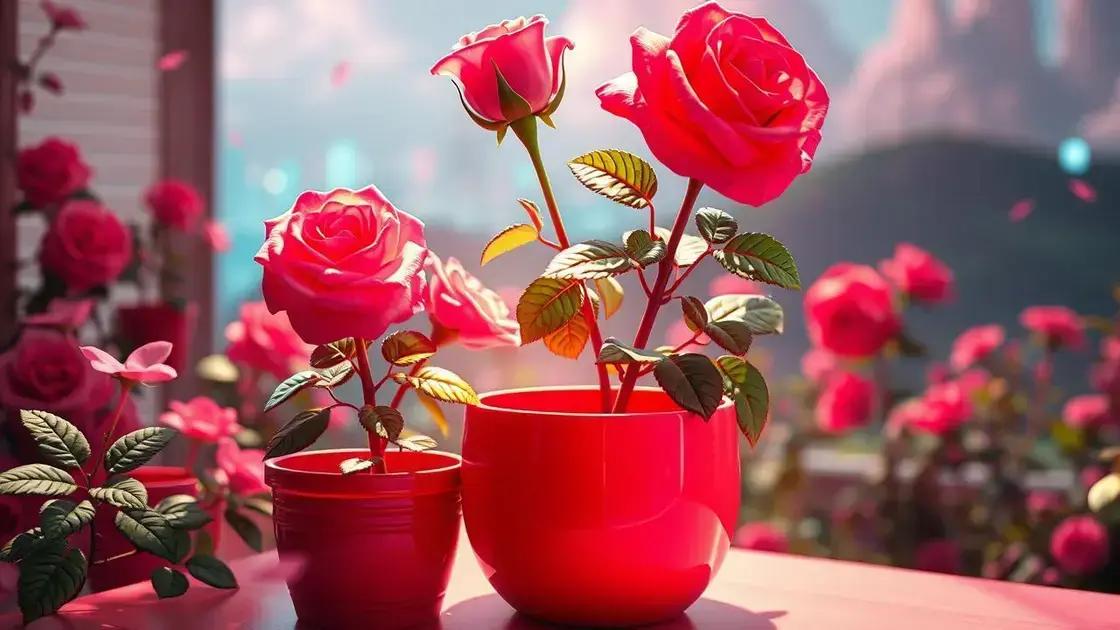How to Care Care of Rose Pot Plant: 7 Essential Tips for Beginners
How to care care of rose pot plant is a common question among gardening enthusiasts. Growing roses can be incredibly rewarding, but it does come with its set of challenges. Are you looking to transform your indoor space with these beautiful blooms? This guide will uncover the secrets of successfully nurturing your rose pot plants, ensuring they thrive all year round.
Table of Contents
ToggleWatering practices for rose pot plants
Watering practices for rose pot plants are crucial for their health and vitality. Proper watering ensures that your roses receive the right amount of moisture, preventing issues like root rot or dehydration. Here are essential tips for effective watering:
- Determine the right frequency: Typically, roses need watering every 1-2 weeks, depending on the climate and pot size.
- Check the soil moisture: Before watering, poke your finger about an inch into the soil. If it’s dry, it’s time to water.
- Water deeply: Ensure that water penetrates the soil to the roots rather than just getting the surface wet.
- Use room-temperature water: Cold water can shock the roots. Allow your water to reach room temperature before applying.
Essential watering techniques to keep in mind:
- Watering in the morning: This helps reduce evaporation and allows the leaves to dry before evening, minimizing disease risk.
- Avoid overhead watering: Water the base of the plant instead of the leaves to prevent fungal diseases.
- Consider the potting soil: Choosing the right potting soil for roses can retain moisture, helping to effectively regulate watering needs.
Knowing how to care care of rose pot plants starts with good watering practices that match their specific needs. Pay attention to the climate and humidity levels, as these factors will influence how often you should water your rose plants. With proper techniques, your roses will thrive, displaying beautiful blooms throughout the year.
Essential nutrients for thriving rose plants

Essential nutrients for thriving rose plants are key to their development and health. Roses require a balanced supply of macronutrients and micronutrients to produce stunning blooms and lush foliage. Here’s how to ensure your rose pot plants receive the nutrients they need:
- Nitrogen: Promotes healthy leaf growth and overall plant vigor.
- Phosphorus: Essential for root development and blooming quality.
- Potassium: Increases disease resistance and strengthens stems.
Micronutrients also play a critical role:
- Iron: Vital for chlorophyll production.
- Magnesium: Aids in photosynthesis and nutrient absorption.
- Calcium: Strengthens cell walls, promoting overall plant structure.
When selecting the right fertilizers, consider these options:
- Granular fertilizers: Slow-release nutrients that feed roses over time.
- Liquid fertilizers: Quick absorption and immediate nutrient delivery.
- Organic options: Compost or well-rotted manure to improve soil health naturally.
To further enhance the growth of your rose pot plants, use best potting soil for indoor plants that retains moisture and supplies nutrients effectively. Remember, the right balance of these nutrients will help your roses thrive, displaying vibrant colours and strong growth.
Common pests and diseases affecting roses
Common pests and diseases affecting roses can threaten the health of your beautiful plants. Identifying these issues early is crucial for effective management and prevention. Here are some of the most frequent challenges that rose pot plants face:
- Aphids: Small insects that suck the sap from rose plants, causing wilting and leaf curling.
- Black spot: A fungal disease manifested by dark spots on leaves, leading to premature leaf drop.
- Spider mites: Tiny pests that create webs and cause yellowing of leaves due to sap consumption.
Effective management strategies for these pests and diseases include:
- Regular inspection: Examine your plants weekly for signs of pests or disease to catch problems early.
- Natural pest control: Introduce beneficial insects like ladybugs to reduce aphid populations.
- Sanitation practices: Remove affected leaves and debris to minimize the spread of diseases like black spot.
Additionally, ensure that your rose pot plants grow in healthy conditions by exploring indoor gardening techniques that promote robust growth and resilience against diseases. Staying proactive with care and monitoring will keep your roses thriving and free from common threats.
In conclusion
Caring for rose pot plants requires a combination of proper watering, nutrition, and vigilant pest management to ensure they thrive. By implementing the essential tips we’ve discussed, from identifying common pests and diseases to understanding their nutrient needs, you can cultivate beautiful and vibrant roses in your garden or home. Don’t forget to explore various techniques to enhance your indoor garden by checking out these tips on enhancing your indoor garden. With dedication and care, your roses can flourish and bring joy to your space.

